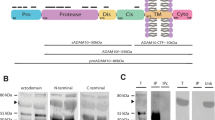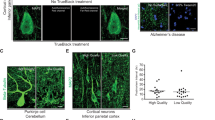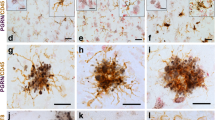Abstract
A growing amount of evidence indicates that matrix metalloproteinases (MMPs) may play an important role in the pathogenesis of Alzheimer’s disease (AD). Stromelysin-1 (MMP-3) plays a central role in activating latent-type MMPs, which are originally secreted as proenzymes. We examined MMP-3 immunoreactivity in the brains of patients who had suffered from Alzheimer’s disease and in those of neurologically normal persons. The interstitium between myelinated axons and astrocytes in the white matter of all brain tissues, and senile plaques in the gray matter of the patients with AD were stained with a monoclonal antibody to MMP-3. Comparison of the number of senile plaques stained with the antibody against MMP-3 in the parietal cortex with that in the hippocampus showed that fewer plaques were stained in the hippocampus. The selective distribution of MMP-3 in the human brain suggests that MMP-3 might play an important role in the pathogenesis of AD, especially in the degradation of β-amyloid protein.
Similar content being viewed by others
Author information
Authors and Affiliations
Additional information
Received: 16 November 1998 / Revised: 6 April / 24 June 1999 / Accepted: 24 June 1999
Rights and permissions
About this article
Cite this article
Yoshiyama, Y., Asahina, M. & Hattori, T. Selective distribution of matrix metalloproteinase-3 (MMP-3) in Alzheimer’s disease brain. Acta Neuropathol 99, 91–95 (2000). https://doi.org/10.1007/PL00007428
Issue Date:
DOI: https://doi.org/10.1007/PL00007428




